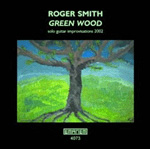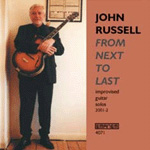| |
Post-Guitar : Roger Smith & John Russell on Emanem
by Derek Taylor
September 2002
Life must be quite vexing for British free improvising guitarists
operating in the wake and shadow cast by Derek Bailey's long
spidery reach. Establishing a style independent from the abiding
influence of the aforementioned elder statesman of idiosyncratic
fretwork is nigh impossible, but there are brave souls who try just
the same. John Russell and Roger Smith are two such stringsmiths.
Both men readily acknowledge the breadth of Bailey's influence,
but this pair of discs shows each one to be decidedly his own man
when it comes to the intricacies and possibilities of solo guitar
improvisation.
 An original
member of John Stevens' Spontaneous Music Ensemble, Smith is by rights
a peer of Bailey's and both improvisers developed their individual
styles somewhat contemporaneously. But while Bailey's fecundity is
now legendary, Smith chose a more reclusive path, appearing on a comparative
handful of recordings (most for the Emanem label) and maintaining
a relatively low profile when it came to public performances. Green
Wood gathers tracks from a trio of tapes recorded in Smith's kitchen
and as such includes ambient house noises, such as the whir of a central
heating system, in several instances. His decision to approach his
strings sans pick also contributes to the intimate feel of the performances. An original
member of John Stevens' Spontaneous Music Ensemble, Smith is by rights
a peer of Bailey's and both improvisers developed their individual
styles somewhat contemporaneously. But while Bailey's fecundity is
now legendary, Smith chose a more reclusive path, appearing on a comparative
handful of recordings (most for the Emanem label) and maintaining
a relatively low profile when it came to public performances. Green
Wood gathers tracks from a trio of tapes recorded in Smith's kitchen
and as such includes ambient house noises, such as the whir of a central
heating system, in several instances. His decision to approach his
strings sans pick also contributes to the intimate feel of the performances.
Compiler Martin Davidson (who also incidentally ascribed titles
to the pieces) makes mention of Smith's Spanish tunings and
these sonorities lend a guiding lyricism to his improvisations that
colors even his most fevered and abstract fingerings. It's
never a case of plinking for plonk's sake. Each piece dissolves
into its successor with demarcations commonly subsumed into an inclusive
programmatic whole. Several tracks cease abruptly, momentarily disrupting
the illusion of contiguity, but isolating one piece from the next
is an exercise likely to diminish the listening experience rather
than demystify it. The better approach is to allow the tracks to
unfold independent of the rigors of picayunish dissection.
Smith's sound much of the time is precise and delicate, but
retains a tensile directness that resists the easy impulse to stray
into obtuse meanderings. He capitalizes effectively on the natural
echophonics of his instrument, holding notes in the air in a manner
that tellingly evinces Bailey's signature volume pedal swells.
Semblances of hooking chords skirt around the fringes, but this
is music that can easily retreat into the background if one doesn't
pay careful attention to the action as it unfolds. Let the ears
stray for even a few seconds and the labyrinth of carefully threaded
lines can lose its linear focus. Shorter interludes intersperse
amongst the longer excursions and effectively vary the terrain while
simultaneously providing passages for listeners to regain their
bearings. One thing seems succinctly made certain by this intimate
recital. Smith's powers of improvisation have been little hindered
by his advanced years and less visible stature on the European performance
scene.
 John
Russell, who is several years Smith's senior, has favored a more rigorous
performance schedule over the years. Frequent collaborations with
Evan Parker, John Butcher and other high profile British improvisers
have augmented his discography considerably since the Seventies. From
Next to Last is not his first solo guitar foray, but it's a fitting
continuation of his prowess in this arena of expression. All the tracks
save "Mopomoso", which was taped in concert at London's Red Room performance
space, were recorded in Davidson's lounge. Again the informal surroundings
add to the flavor of spontaneity and intimacy. The cover photo interestingly
depicts him cradling what on first glance appears to be a hollow body
electric model, but as the sounds of the disc soon reveal, all of
the improvisations that make up the program are entirely acoustic.
Davidson states in the liner notes that Russell has opted for acoustic
strings exclusively since 1977. John
Russell, who is several years Smith's senior, has favored a more rigorous
performance schedule over the years. Frequent collaborations with
Evan Parker, John Butcher and other high profile British improvisers
have augmented his discography considerably since the Seventies. From
Next to Last is not his first solo guitar foray, but it's a fitting
continuation of his prowess in this arena of expression. All the tracks
save "Mopomoso", which was taped in concert at London's Red Room performance
space, were recorded in Davidson's lounge. Again the informal surroundings
add to the flavor of spontaneity and intimacy. The cover photo interestingly
depicts him cradling what on first glance appears to be a hollow body
electric model, but as the sounds of the disc soon reveal, all of
the improvisations that make up the program are entirely acoustic.
Davidson states in the liner notes that Russell has opted for acoustic
strings exclusively since 1977.
Compared to Smith, Russell's approach seems less consciously
concise, his fingerings more craggy and crenellated with wide open
spaces plugged between them, perhaps due in part to his use of a
plectrum. His figures are often shard-like and prickly, suggesting
tightly wound wiry spindles and recalling a different facet of the
Bailey prism refracted by his own beam of creative light. The results
are sparser in feel and texture and require more listener patience
to plumb and connect. At times his peregrinations feel almost like
an exercise in 'hunt and peck' string foraging, but Russell's
logical patterns gradually reveal themselves as far from random.
His frequent punctuating strums, placed strategically as bookends
to particularly knotted braids of notes, add both to the tension
and dynamism of the pieces.
Russell also differs from Smith in his preference for lengthier
improvisatory voyages. The extended lengths of the tracks necessitate
greater patience on the part of the listener, but Russell sounds
cognizant of this from the onset. When a particular direction starts
offering diminishing returns he wisely switches up and moves along
a fresh trajectory. Versatility counts as much as virtuosity in
such settings and Russell uses elements of both to sustain interest
over the long haul. Bailey's influence may loom large, but
what stands out on these discs is the staunch individualism of two
artists. Both Russell and Smith have been at their respective games
for decades and each man has honed an individual style that guides
the way in these solitary and highly idiosyncratic sessions.
|
|
|
|
|

